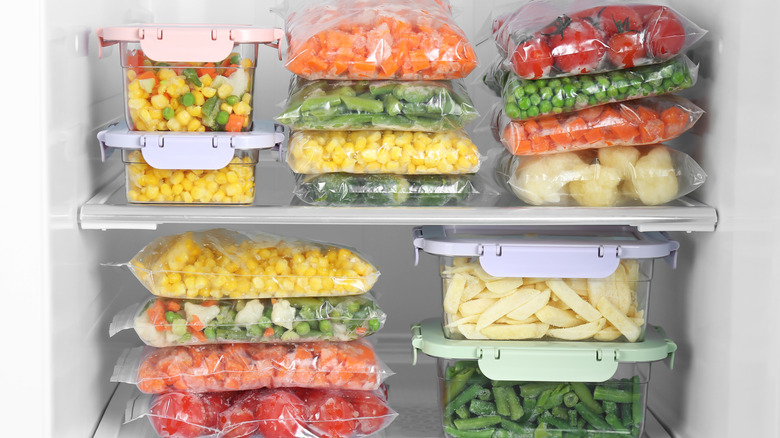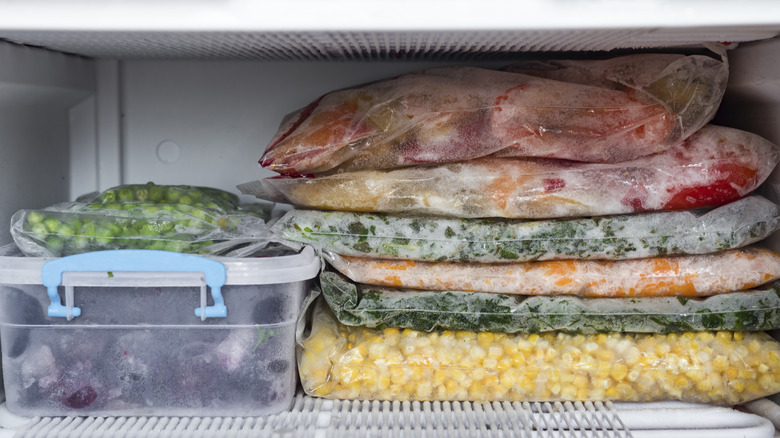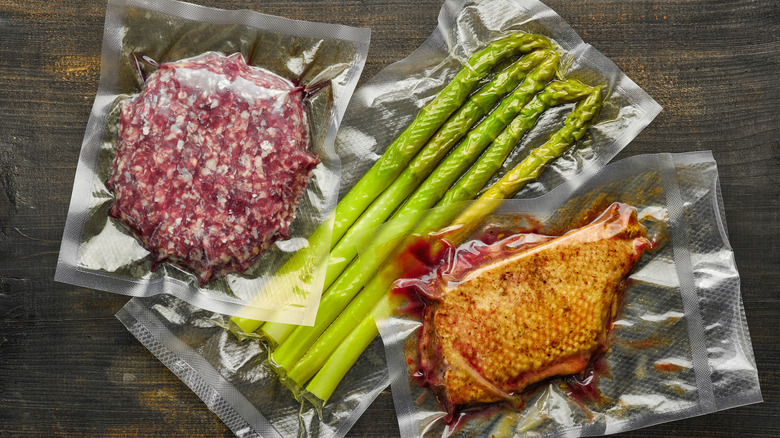Maximize Your Freezer Space (And More) By Freezing Food In Bags
You just got home from picking up a grocery order for the week and now it's time to put everything away. While this sounds easy at first, considering that you already know where everything should go, things get kind of complicated when you get to the freezer. The freezer's not as big as your fridge, which means you can only fit so much of your groceries in there before it starts getting cluttered. You have to take stuff out, put stuff back in, position stuff just so — it's like you're playing the world's coldest game of Tetris.
It goes without saying that a well-organized kitchen is an efficient one, and your freezer is no different. Whether you're piling in frozen vegetables, frozen pizza, or cartons of ice cream, your freezer could stand to undergo a little bit of reorganization. There are plenty of different ways to go about this, such as storing your food in freezer bins to ensure that nothing gets piled up and everything stays separate or keeping a detailed inventory list about what's in your freezer so you can know what to throw out to prevent clutter. The main focus is to find a balance between managing what little inventory space you have and storing as much food as you can.
While freezer bins and inventory lists are sound ideas, there's another way that can ensure you can store all your frozen products together and still have plenty of space left over.
How freezer bags help with storage space
The major problem with freezer space lies within the design of your freezer compared to the shape and size of the products you're putting in it. How can a bag of frozen corn fit against a bag of French fries? How can a Tupperware container fit when there's already a box of frozen pizza and a box of soft pretzels? If only there was a way to flatten everything out to make it all fit easier.
According to J. Kenji Lopez-Alt of Serious Eats, a very good trick to solving this problem involves using freezer bags. True to their name, freezer bags are large plastic bags that are meant to preserve foods long-term in the freezer. By storing meats, vegetables, and even liquids such as soups or broth in these bags and then smoothing them out until they're flat, these once-bulky and cumbersome products can now be stacked on top of each other, creating not just a more organized freezer but one where there is far more space.
Another similar method has you vacuum-seal your products. This involves placing your food items, such as frozen potatoes or ground meat, inside a specially-designed bag and then sucking the air out using a vacuum. This not only compresses the bag into a smaller shape but the lack of air also helps to ensure the food stays fresh by preventing water crystals or bacterial growth from building within the bag.
How to vacuum seal bags without a vacuum
While the idea of vacuum sealing has its benefits, the main problem with it is that, just as the name implies, a vacuum is needed to remove the air from the bag. Is it possible to achieve the benefits of vacuum sealing without having to purchase a vacuum sealer?
One very simple method to vacuum seal your food, if you have any solid foods such as meat or vegetables, is to simply seal the food in a plastic bag and flatten it into an even layer. Press as much air as you can out of the bag, but leave the top of the bag open slightly. Hold the bag by the unsealed corner, and then gently lower it into a pot full of water, squeezing out any air bubbles while you do so. Once the water reaches the top of the bag, gently seal it closed. Repeat the process if necessary to ensure there's no air in the bag and the food looks "molded" into the plastic.
Another good solution has you slip a straw into the open end of the plastic bag. While pressing down on the bag, suck the air out through the straw until the bag collapses and forms around the food within it. Slowly slide the straw out as you suck the air out before quickly sealing the bag shut. It's recommended you do this with solids, or else you'll just find that you're sucking cold soup out of a plastic bag.


